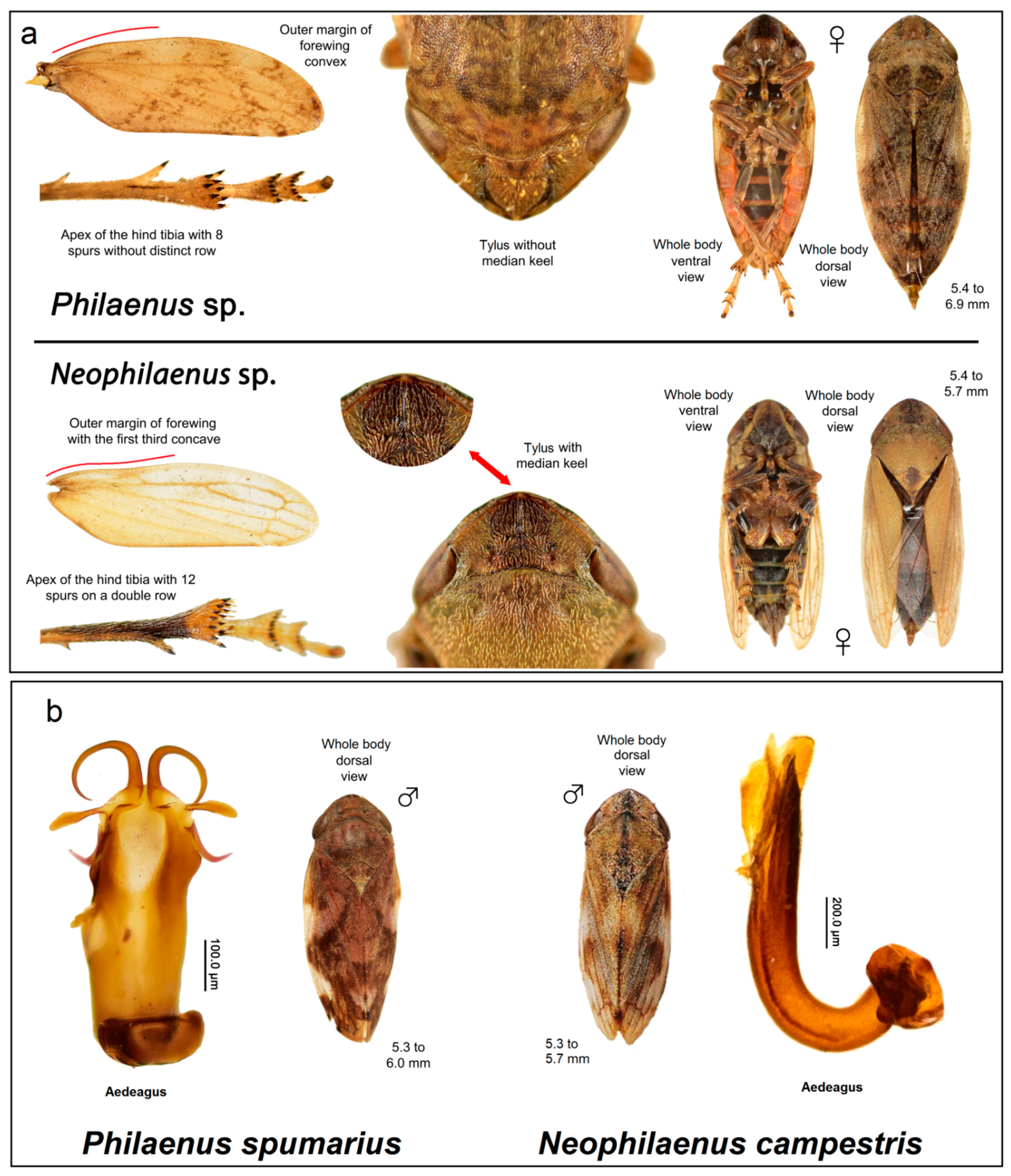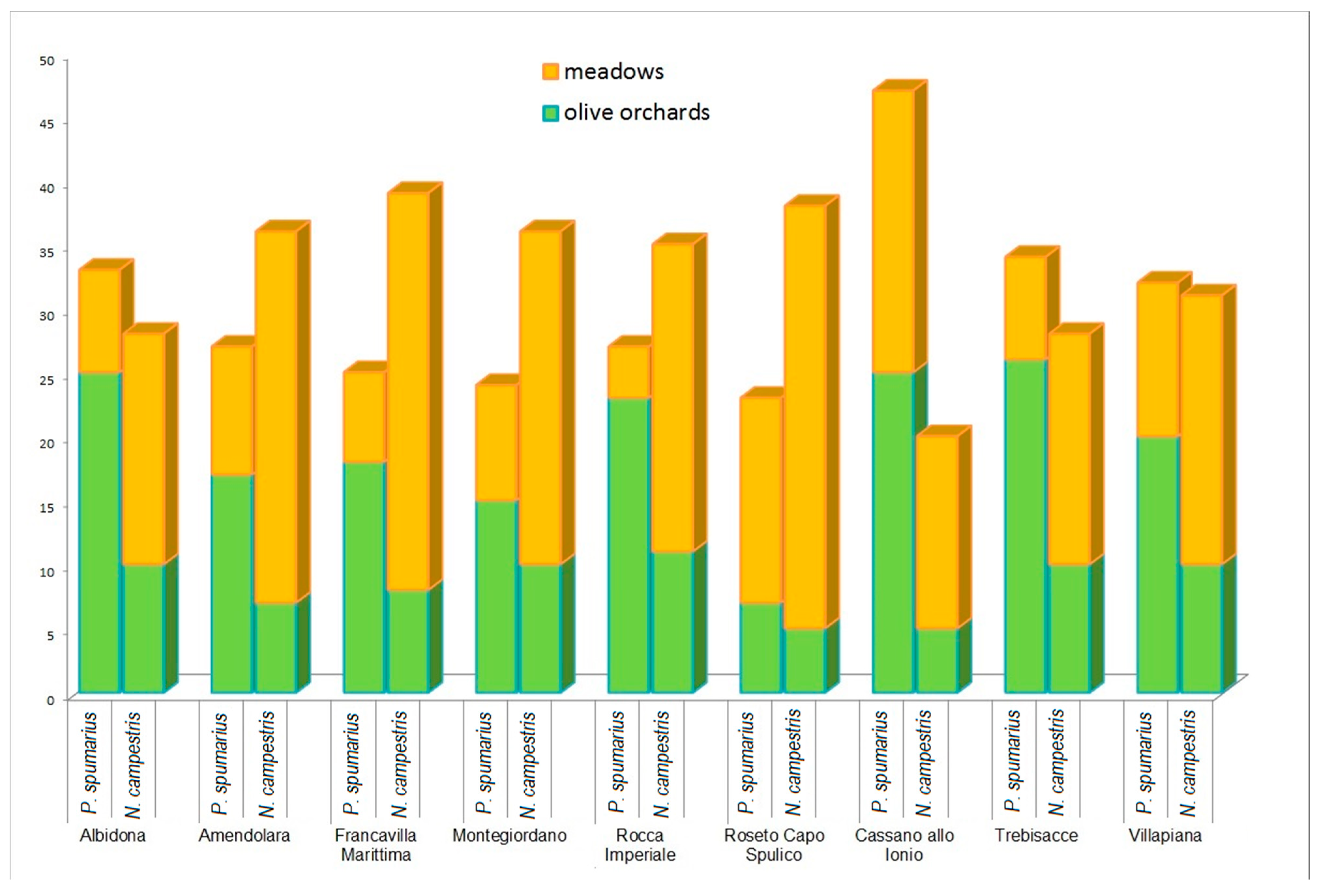Preliminary Molecular Survey of the Possible Presence of Xylella fastidiosa in the Upper Ionian Coasts of Calabria, Italy, through the Capture and Analysis of Its Main Vector Insects
Abstract
Simple Summary
Abstract
1. Introduction
2. Materials and Methods
2.1. Vector Insect Collection and Identification
2.2. Statistical Analysis
2.3. Detection of X. fastidiosa in Vector Insects
3. Results and Discussions
3.1. Insect Identification
3.2. Molecular Analysis of the Spittlebugs
4. Conclusions
Author Contributions
Funding
Institutional Review Board Statement
Data Availability Statement
Acknowledgments
Conflicts of Interest
References
- EFSA European Food Safety Authority. Update of the Xylella spp. host plant database—Systematic literature search up to 30 June 2019. EFSA J. 2020, 18, 6114. [Google Scholar] [CrossRef]
- Randall, J.J.; Goldberg, N.P.; Kemp, J.D.; Radionenko, M.; French, J.M.; Olsen, M.W.; Hanson, S.F. Genetic Analysis of a novel Xylella fastidiosa subspecies found in the southwestern United States. Appl. Environ. Microbiol. 2009, 75, 5631–5638. [Google Scholar] [CrossRef]
- Schaad, N.W.; Postnikova, E.; Lacy, G.; Fatmi, M.; Chang, C.J. Xylella fastidiosa subspecies: X. fastidiosa subsp. piercei, subsp. nov., X. fastidiosa subsp. multiplex subsp. nov., and X. fastidiosa subsp. pauca subsp. nov. Syst. Appl. Microbiol. 2004, 27, 290–300, Erratum in Syst. Appl. Microbiol. 2004, 27, 763, doi:10.1078/0723202042369848. [Google Scholar] [CrossRef] [PubMed]
- Denancé, N.; Briand, M.; Gaborieau, R.; Gaillard, S.; Jacques, M.-A. Identification of genetic relationships and subspecies signatures in Xylella fastidiosa. BMC Genom. 2019, 20, 239. [Google Scholar] [CrossRef] [PubMed]
- Potnis, N.; Kandel, P.P.; Merfa, M.V.; Retchless, A.C.; Parker, J.K.; Stenger, D.C.; Almeida, R.P.P.; Bergsma-Vlami, M.; Westenberg, M.; Cobine, P.A.; et al. Patterns of inter- and intrasubspecific homologous recombination inform eco-evolutionary dynamics of Xylella fastidiosa. ISME J. 2019, 13, 2319–2333. [Google Scholar] [CrossRef] [PubMed]
- Vanhove, M.; Retchless, A.C.; Sicard, A.; Rieux, A.; Coletta-Filho, H.D.; De La Fuente, L.; Stenger, D.C.; Almeida, R.P.P. Genomic Diversity and Recombination among Xylella fastidiosa Subspecies. Appl. Environ. Microbiol. 2019, 85, e02972-18. [Google Scholar] [CrossRef] [PubMed]
- Cariddi, C.; Saponari, M.; Boscia, D.; De Stradis, A.; Loconsole, G.; Nigro, F.; Porcelli, F.; Potere, O.; Martelli, G.P. Isolation of a Xylella fastidiosa strain infecting olive and oleander in Apulia, Italy. J. Plant Pathol. 2014, 96, 425–429. [Google Scholar]
- Saponari, M.; Boscia, D.; Loconsole, G.; Palmisano, F.; Savino, V.; Potere, O.; Martelli, G.P. New hosts of Xylella fastidiosa strain CoDiRO in Apulia. J. Plant Pathol. 2014, 96, 603–611. [Google Scholar]
- Saponari, M.; Boscia, D.; Nigro, F.; Martelli, G.P. Identification of DNA sequences related to Xylella fastidiosa in oleander, almond and olive trees exhibiting leaf scorch symptoms in Apulia (southerrn Italy). J. Plant Pathol. 2013, 95, 668. [Google Scholar]
- Regione Puglia. Available online: http://sit.puglia.it/portal/portale_gestione_agricoltura/Cartografie (accessed on 13 February 2021).
- Fierro, A.; Liccardo, A.; Porcelli, F. A lattice model to manage the vector and the infection of the Xylella fastidiosa on olive trees. Sci. Rep. 2019, 9, 8723. [Google Scholar] [CrossRef]
- Saponari, M.; Giampetruzzi, A.; Loconsole, G.; Boscia, D.; Saldarelli, P. Xylella fastidiosa in Olive in Apulia: Where We Stand. Phytopathology 2019, 109, 175–186. [Google Scholar] [CrossRef] [PubMed]
- Lombardo, L.; Farolfi, C.; Capri, E. Sustainability Certification, a New Path of Value Creation in the Olive Oil Sector: The ITALIAN Case Study. Foods 2021, 10, 501. [Google Scholar] [CrossRef] [PubMed]
- Cavalieri, V.; Dongiovanni, C.; Tauro, D.; Altamura, G.; Di Carolo, M.; Fumarola, G.; Saponari, M.; Bosco, D. Transmission of the CODIRO strain of Xylella fastidiosa by different insect species. In Proceedings of the XI European Congress of Press Publications, Voghera, Italy, 24 July 2018; pp. 144–145. [Google Scholar]
- Elbeaino, T.; Yaseen, T.; Valentini, F.; Ben Moussa, I.E.; Mazzoni, V.; D’onghia, A.M. Identification of three potential insect vectors of Xylella fastidiosa in southern Italy. Phytopathol. Mediterr. 2014, 53, 328–332. [Google Scholar] [CrossRef]
- Cavalieri, V.; Altamura, G.; Fumarola, G.; Di Carolo, M.; Saponari, M.; Cornara, D.; Bosco, D.; Dongiovanni, C. Transmission of Xylella fastidiosa Subspecies Pauca Sequence Type 53 by Different Insect Species. Insects 2019, 10, 324. [Google Scholar] [CrossRef] [PubMed]
- Cornara, D.; Marra, M.; Tedone, B.; Cavalieri, V.; Porcelli, F.; Fereres, A.; Purcell, A.; Saponari, M. No evidence for cicadas’ implication in Xylella fastidiosa epidemiology. Èntomol. Gen. 2020, 40, 125–132. [Google Scholar] [CrossRef]
- Saponari, M.; Loconsole, G.; Cornara, D.; Yokomi, R.K.; De Stradis, A.; Boscia, D.; Bosco, D.; Martelli, G.P.; Krugner, R.; Porcelli, F. Infectivity and transmission of Xylellua fastidiosa by Philaenus spumarius (Hemiptera: Aphrophoridae) in Apulia, Italy. J. Econ. Entomol. 2014, 107, 1316–1319. [Google Scholar] [CrossRef] [PubMed]
- Cornara, D.; Saponari, M.; Zeilinger, A.R.; De Stradis, A.; Boscia, D.; Loconsole, G.; Bosco, D.; Martelli, G.P.; Almeida, R.P.P.; Porcelli, F. Spittlebugs as vectors of Xylella fastidiosa in olive orchards in Italy. J. Pest Sci. 2017, 90, 521–530. [Google Scholar] [CrossRef] [PubMed]
- Cornara, D.; Bosco, D.; Fereres, A. Philaenus spumarius: When an old acquaintance becomes a new threat to European agriculture. J. Pest Sci. 2018, 91, 957–972. [Google Scholar] [CrossRef]
- Bodino, N.; Cavalieri, V.; Dongiovanni, C.; Saladini, M.A.; Simonetto, A.; Volani, S.; Plazio, E.; Altamura, G.; Tauro, D.; Gilioli, G.; et al. Spittlebugs of Mediterranean Olive Groves: Host-Plant Exploitation throughout the Year. Insects 2020, 11, 130. [Google Scholar] [CrossRef]
- Emergenza Xylella. Available online: http://www.emergenzaxylella.it/portal/portale_gestione_agricoltura/Documenti/Specie (accessed on 13 February 2021).
- Lago, C.; Morente, M.; De las Heras-Bravo, D.; Campoy, A.M.; Rodriguez-Ballester, F.; Plaza, M.; Moreno, A.; Fereres, A. Dispersal ability of Neophilaenus campestris, a vector of Xylella fastidiosa, from olive groves to over-summering hosts. bioRxiv 2020. [Google Scholar] [CrossRef]
- Bodino, N.; Cavalieri, V.; Dongiovanni, C.; Simonetto, A.; Saladini, M.A.; Plazio, E.; Gilioli, G.; Molinatto, G.; Saponari, M.; Bosco, D. Dispersal of Philaenus spumarius (Hemiptera: Aphrophoridae), a Vector of Xylella fastidiosa, in Olive Grove and Meadow Agroecosystems. Environ. Entomol. 2021, 50, 267–279. [Google Scholar] [CrossRef]
- EFSA Panel on Plant Health (PLH). Update of the Scientific Opinion on the risks to plant health posed by Xylella fastidiosa in the EU territory. EFSA J. 2019, 17, e05665. [Google Scholar] [CrossRef]
- EFSA Panel on Plant Health (PLH). Effectiveness of in planta control measures for Xylella fastidiosa. EFSA J. 2019, 17, 5666. [Google Scholar] [CrossRef]
- ISTAT (Italian National Institute of Statistics) Cultivations: Grapes, Wine, Olives, Oil. Available online: http://dati.istat.it/Index.aspx?QueryId=33706# (accessed on 13 January 2021).
- Purcell, A.H.; Porcelli, F.; Cornara, D.; Bosco, D.; Picciau, L. Characteristics and Identification of Xylem-Sap Feeders; Massimiliano, M., Ed.; Area per le Politiche per lo Sviluppo Rurale, Servizio Agricoltura, Osservatorio Fitosanitario Regionale: Puglia, Italy, 2014; 30p, Available online: https://www.ponteproject.eu/protocols-xylella/characteristics-identification-xylem-sap-feeders/ (accessed on 13 February 2021).
- Germain, J.F.; Lester, K.; Cornara, D.; EPPO. PM 7/141 (1) Philaenus spumarius, Philaenus italosignus and Neophilaenus campestris. EPPO Bull. 2020, 50, 32–40. [Google Scholar] [CrossRef]
- EPPO. (European and Mediterranean Plant Protection Organization). PM 7/24 (4) Xylella fastidiosa. EPPO Bull. 2019, 49, 175–227. [Google Scholar] [CrossRef]
- Minsavage, G.V.; Thompson, C.M.; Hopkins, D.L.; Leite, R.M.V.B.C.; Stall, R.E. Development of a polymerase chain reaction protocol for detection of Xylella fastidiosa in plant tissue. Phytopathology 1994, 84, 456–461. [Google Scholar] [CrossRef]
- EPPO (European and Mediterranean Plant Protection Organization). PM 7/24 (3) Xylella fastidiosa. EPPO Bull. 2018, 48, 175–218. [Google Scholar] [CrossRef]
- Panzavolta, T.; Bracalini, M.; Croci, F.; Ghelardini, L.; Luti, S.; Campigli, S.; Goti, E.; Marchi, R.; Tiberi, R.; Marchi, G. Philaenus italosignus a potential vector of Xylella fastidiosa: Occurrence of the spittlebug on olive trees in Tuscany (Italy). Bull. Insectol. 2019, 72, 317–320. [Google Scholar]





Publisher’s Note: MDPI stays neutral with regard to jurisdictional claims in published maps and institutional affiliations. |
© 2021 by the authors. Licensee MDPI, Basel, Switzerland. This article is an open access article distributed under the terms and conditions of the Creative Commons Attribution (CC BY) license (https://creativecommons.org/licenses/by/4.0/).
Share and Cite
Lombardo, L.; Rizzo, P.; Novellis, C.; Vizzarri, V. Preliminary Molecular Survey of the Possible Presence of Xylella fastidiosa in the Upper Ionian Coasts of Calabria, Italy, through the Capture and Analysis of Its Main Vector Insects. Insects 2021, 12, 446. https://doi.org/10.3390/insects12050446
Lombardo L, Rizzo P, Novellis C, Vizzarri V. Preliminary Molecular Survey of the Possible Presence of Xylella fastidiosa in the Upper Ionian Coasts of Calabria, Italy, through the Capture and Analysis of Its Main Vector Insects. Insects. 2021; 12(5):446. https://doi.org/10.3390/insects12050446
Chicago/Turabian StyleLombardo, Luca, Pierluigi Rizzo, Carmine Novellis, and Veronica Vizzarri. 2021. "Preliminary Molecular Survey of the Possible Presence of Xylella fastidiosa in the Upper Ionian Coasts of Calabria, Italy, through the Capture and Analysis of Its Main Vector Insects" Insects 12, no. 5: 446. https://doi.org/10.3390/insects12050446
APA StyleLombardo, L., Rizzo, P., Novellis, C., & Vizzarri, V. (2021). Preliminary Molecular Survey of the Possible Presence of Xylella fastidiosa in the Upper Ionian Coasts of Calabria, Italy, through the Capture and Analysis of Its Main Vector Insects. Insects, 12(5), 446. https://doi.org/10.3390/insects12050446





